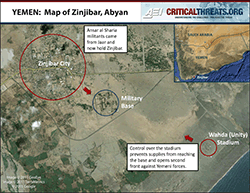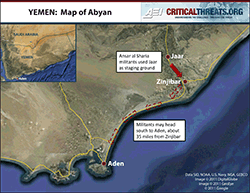{{currentView.title}}
July 08, 2011
Al Qaeda's Gains in South Yemen
The collapse of the Yemeni state into Sana’a and the redeployment of elite counter-terrorism units from al Qaeda strongholds to the capital created a power and security vacuum.[1] Al Qaeda has benefited from this development in south Yemen. Islamist militants have demonstrated the capacity to take and hold territory from state control. These territorial gains increase al Qaeda’s operating space in Yemen.
 |
Islamist militant groups took advantage of the situation and challenged local power structures in south Yemen, where al Qaeda already had strongholds. Though the Yemeni government has historically been quick to designate subversive elements as al Qaeda operatives, there are indications that some of the militant groups do subscribe to al Qaeda’s radical Islamist ideology and have some form of a connection to al Qaeda in the Arabian Peninsula (AQAP). AQAP’s shari’a official, Abu Zubair Adil al Abab, held an audio interview in mid-April in which he claimed control of Jaar in Abyan. Jaar had fallen under the control of Islamist militants in March.[2] Abab also noted that al Qaeda in Yemen introduces itself as “Ansar al Sharia,” or Supporters of Islamic Law, in the interview.[3] The strongest militant group in Abyan governorate operated under this name by mid-June.[4]
Ansar al Sharia’s success in establishing control over strategic territory is alarming. Gaining control of Jaar in Abyan created a strong foothold for the militants.[5] An estimated 300 militants entered Zinjibar, the capital of Abyan governorate, in a coordinated assault on May 27.[6] They have successively increased their control over surrounding areas. The militants reportedly have access to machine guns, Katyusha-type rockets, and rocket-propelled grenades, which they have used both in clashes in the city and to ambush military convoys.[7] They are also highly disciplined and are maneuvering in cells.[8] Militants attempted to gain control of the local military base, that of the 25th mechanized brigade, just outside of Zinjibar on June 11, but were repulsed.[9] Instead, militants took control of the nearby al Wahda (Unity) Stadium, a storage and provision site for the military base, and now hold positions on either side of the military base.[10] Defeating the Yemeni military in Zinjibar would open up a direct path to port city of Aden, the former capital of south Yemen and home to one of Yemen’s two oil refineries.[11]
The Islamist militants have consolidated their control and are attempting to enforce Islamic law. Local residents reported that the militants acted as protectors of the population by preventing looting, for example.[12] Governance of captured territory also seems to be a priority: government and security officials fled and the militants replaced them with locals.[13] Appointing locals, rather than foreigners or northerners, may be an effort to avoid backlash and to win over the population. The militants also appear to be appeasing the population by requiring traders to sell basic goods at below-market prices and by providing public services.[14] Money does not appear to be in short supply. Ansar al Sharia offered a five million rial (23,000 USD) reward for information leading to the killing or capture of twelve Yemeni military commanders and pilots.[15] Yemenis may chafe at an enforcement of strict Islamic law, which militants have sought to promote in captured towns. The militants have required that women travel outside of their homes with chaperones. They are also actively recruiting young men to join their ranks.[16]
The Yemeni government and military have failed to respond sufficiently to the threat posed by the militants in Abyan governorate. The government, paralyzed by the political crisis in Sana’a, does not have the resources to mobilize to prevent the pending humanitarian crisis in the south.[17] The military’s response has been haphazard: the air force executed bombing raids targeting suspected militants hideouts in Zinjibar and nearby Jaar and local soldiers engaged the militants in the streets. The 25th mechanized brigade consists of an estimated 2,000 troops.[18] Reinforcements arrived in the form of the 111th, 119th, and 201st infantry brigades.[19] The 119th and 201st were withdrawn about two miles from the city as part of a “tactical move” on June 21 despite claims that the Yemeni military was on the verge of regaining the city.[20] It is unclear how long the embattled soldiers can hold out in Zinjibar cut off from supplies. Yemen’s defense ministry has recognized the risk that the fall of Zinjibar poses to Aden: Yemeni troops are deploying to protect Aden’s perimeters and supplementary youth militias have been established.[21]
 |
The militants have the momentum, however. Zinjibar and Jaar have become destinations for militants.[22] Should Ansar al Sharia defeat the Yemeni military in Zinjibar, Abyan would become a staging ground for an offensive to take the strategic city of Aden.[23] The fall of Aden raises the possibility of the fall of the south, which will have resounding effects on the future of the Yemeni state.[24] Al Qaeda would gain relative freedom of movement from the Arabian Sea to the Saudi border, significantly increasing the risk of an attack on an international or Saudi oil target, and could erect a form of an Islamist government in its territories. The Yemeni state would not only lose its southern port city of Aden, but would also lose revenues from southern oil. Should the Yemeni military or some other actor fail to halt al Qaeda’s advance, there is the very real prospect that al Qaeda could establish an Islamic emirate in south Yemen.
